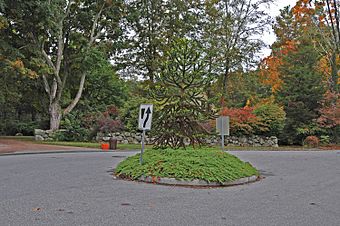Pequot Fort facts for kids
Quick facts for kids |
|
|
Pequot Fort
|
|
 |
|
| Location | Pequot Ave., Groton, Connecticut |
|---|---|
| Area | 3 acres (1.2 ha) |
| Built | 1637 |
| NRHP reference No. | 89002294 |
| Added to NRHP | January 19, 1990 |
The Pequot Fort was a village built by the Pequot Native American tribe. It was located in what is now Groton, Connecticut, in the United States. The fort was built on a hill overlooking the Mystic River. It had strong walls made of logs, called a palisade, to protect the people inside.
This fort was an important home for the Pequot people until it was destroyed in 1637. This happened during the Pequot War, when forces from the Puritan colonies and the Mohegan tribe attacked it. This event is known as the Mystic massacre.
Today, the exact spot where the fort stood is not fully known. However, a small memorial stands at Pequot Avenue and Clift Street to remember it. There used to be a statue of Major John Mason, who led the attack, but it was moved in 1995 after protests from Pequot tribal members. The area where the fort was located became a protected historical site in 1990.
Contents
The Pequot Fort's Story
The Pequot Fort was on top of Pequot Hill, near a place called West Mystic. In the early 1600s, the Pequots were the biggest and most powerful Native American tribe in what is now eastern Connecticut.
Rising Tensions and the Pequot War
In the 1630s, problems grew between the Pequots and their neighbors. These neighbors included the Narragansetts and Mohegans tribes. There were also English settlers from the Connecticut and Saybrook colonies, and Dutch settlers from New Netherland.
The Pequot War started in 1636. This happened after an English trader named John Oldham was found dead on his boat. The Pequots were accused of helping the people who killed him. Because of this, a village of theirs was burned by a force from the Massachusetts Bay Colony. This group was led by John Endecott.
The Mystic Massacre
The Pequots fought back by attacking Saybrook and other Connecticut towns. In response, the Connecticut colonies planned another attack. Captain John Mason led a group of 90 colonists and 100 Mohegan warriors. Later, some Narragansett warriors joined them.
On May 26, 1637, this group attacked the Pequot fort at Mystic. This event is called the Mystic massacre. During the attack, many Pequot men, women, and children died, and the fort was burned. This attack caused the remaining Pequots to flee. By the end of the war, the Pequot tribe was no longer a strong political group.
The John Mason Statue
In 1889, a statue of John Mason was placed on Pequot Hill. It was near where the attack happened. The statue was designed by James C.G. Hamilton. A plaque on the memorial talked about Mason's role in leading the attack.
In the early 1990s, members of the Pequot tribe asked for the statue to be moved. They felt it was wrong to honor someone who had caused so much death. They also believed the statue was on sacred land. After many discussions, the statue was moved to Windsor in 1996. The spot where the statue once stood is now home to what the Pequots call a "tree of life."
Finding the Fort's Remains
Experts have studied the top of Pequot Hill. They have found many items from Native American and early colonial times. These findings include things that suggest there was a village with log walls. What they found matches old records from the 1600s to the 1800s about the fort after it was destroyed.
See also
 In Spanish: Pequot Fort para niños
In Spanish: Pequot Fort para niños



